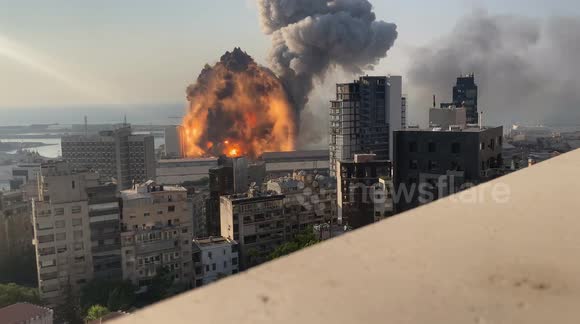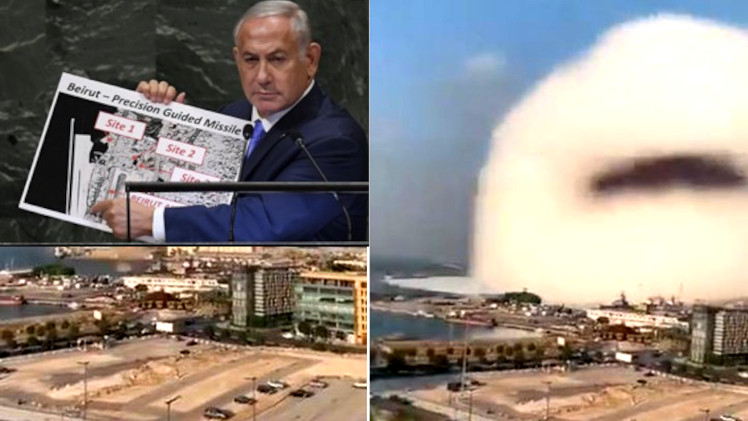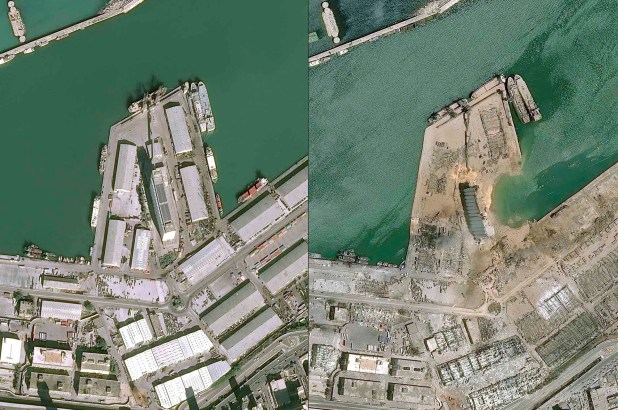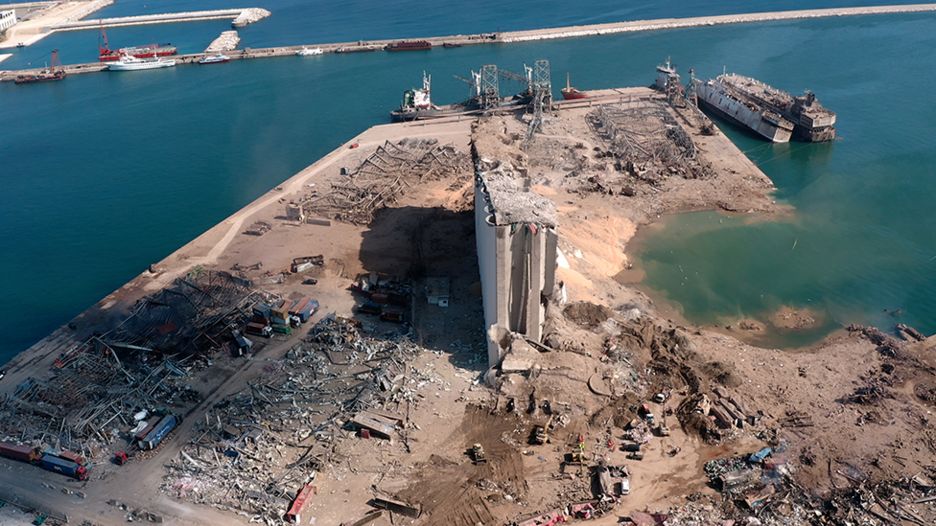In this post there are more perspectives and calculations,
Detonation velocities and differences between Sailor Hat and Beirut
If the Sailor Hat test mentioned in this post had 450 tons of TNT, the Beirut explosion would thus be about two and a half times more powerful. But in the Sailor Hat all the TNT was packed into a semispherical pile which may have made the explosion occur faster, at least if they used several detonators, or if a detonator was placed at the center. It is a given that a detonation happens fast, but not all are equally fast. In the Wiki table of explosive detonation velocities, one finds the detonation velocity of ammonium nitrate to be the slowest on this list with only 2700m/s, while the next in the list, silver azide has a detonation velocity of 4000 m/s, TNT of 6900 m/s etc. Another difference with the Sailor Hat, was that the content was stored in a warehouse, not in direct contact with each other which should help to slow it down. In Beirut, the AN was stored one bag on top of another according to the photo in this post and with one bag containing 1000 kg (see lower right next to the head of the squatting worker).
Under ANFO or ammonium nitrate fuel oil, one finds: ANFO - Wikipedia

If one sees the video and compare with the image below, it much have been taken from a place really nearby. The arrow points to the warehouse that went up.

A comment on videos with edited-in missiles
I found a couple of videos, for instance, this, which claims they can see a missile, but there is also someone who explains how such videos are done: Video one and two.
The videos that have been edited were taken close to the event:
One is similar to a clip from Alghad TV which is taken from the harbor area.
Another clip Beirut Explosion catches cyclist on the road is also used in an edited version. It is taken from the other side of the silos compared to the clip from Alghad TV. I downloaded one of them, played it with a negative filter on, but there is nothing to see.
The sequence of events
In this picture from Al-ain.com one can see the sequence of burning, brown smoke (small detonation), then the major detonation. What one sees may help in the section on chemistry, and be an aid to do calculations.

Chemistry and the produced energy from the explosion

There are several possible compounds of nitrogen generated as products of a decomposition of AN: Nitric oxide (NO), nitrogen(II) oxide, or nitrogen monoxide which is colorless. Nitrogen dioxide (NO2), nitrogen(IV) oxide which is a reddish brown gas Nitrous oxide (N2O), nitrogen(0,II) oxide is colorless
Process 4) generates 2597KJ/Mol or 61.9 % of TNT while the presence of brown gas in the picture indicates process 5) that generates NO2 and 944 KJ/Mol this is compared to the TNT (4196KJ/Mol) about 22.5 %.
Calculating the released energy in TNT - an estimate
If one next takes 2750 tons of AN and converts the energy following process 4) into TNT it would be 1700 tons of TNT if process 5) it would be 620 tons of TNT. Each calculation is assuming only one process was taking place for the whole lot of 2750 tons. Probably this is not so, and there are also processes 3), 6) and 7), but for now I ignore them, as 6) and 7) are in the same lower range as process 5). The calculations are just estimates, but if one takes the average of the energy that would be generated with process 4) and 5) like in half the amount reacted according to process 4) the other according to process 5) then the average would be 1250 tons or with round figures 1.3 kiloton of TNT, which in the range Pashalis mentioned and the same as given in the following illustration:
There may still be something missing in terms of data and test to determine in what proportion the processes took place. The range of tolerance 1.0 to 1.5 kt TNT leaves room for substantial secondary influences, which could have helped the AN to go off in a big way. To learn about this, a lot will depend on how open-minded the investigators dare to be, and how thorough they can do their collections of data.
With the speed of sound to Cyprus
Detonation velocities and differences between Sailor Hat and Beirut
If the Sailor Hat test mentioned in this post had 450 tons of TNT, the Beirut explosion would thus be about two and a half times more powerful. But in the Sailor Hat all the TNT was packed into a semispherical pile which may have made the explosion occur faster, at least if they used several detonators, or if a detonator was placed at the center. It is a given that a detonation happens fast, but not all are equally fast. In the Wiki table of explosive detonation velocities, one finds the detonation velocity of ammonium nitrate to be the slowest on this list with only 2700m/s, while the next in the list, silver azide has a detonation velocity of 4000 m/s, TNT of 6900 m/s etc. Another difference with the Sailor Hat, was that the content was stored in a warehouse, not in direct contact with each other which should help to slow it down. In Beirut, the AN was stored one bag on top of another according to the photo in this post and with one bag containing 1000 kg (see lower right next to the head of the squatting worker).
One could make an estimate of the area of storage needed. The density of AN is 1.73 g/cm^3 so judging from the picture in the above post, one bag would occupy an area of 1 m^2. Being on top of one another, it would be 2 bags/m^2. With 2750 tons that would be 1350 m^2 In the picture one sees the warehouse roof, one side of the roof appears to have two rows of transparent sections. Suppose the roof is 15 meters on each side, or at surface level about 25 meters across, then the bags would take up an area of roughly 55x25 meters. If the width was 30 meters it would be a length of 45 meters. How might this detonate and create such an impressive vapor dome?Just saw this one on Twitter, supposed to be a picture of the storage condition for the ammonium nitrate at the warehouse.
View attachment 38136
Under ANFO or ammonium nitrate fuel oil, one finds: ANFO - Wikipedia
One difference between ANFO and AN is the 6% of fuel oil, and since ammonium nitrate is hygroscopic it would tend to absorb water from the air, form a cake and be pretty solid after these years of being stored in open bags and in a humid area near the port. Therefore even if one poured diesel fuel on the bags the mix would not readily resemble ANFO and if ANFO needs a booster, the AN would need a super booster. Where is it? In this video, perhaps the closest available recording taken next to the warehouse, one can see that there are minor explosions and that things being to get chaotic inside the warehouse: It is from http://alaraby.tv Translated from Arabic: "How did the ship carrying the death shipment arrive at Beirut Harbor? Here are the details." The section with the warehouse is shown at the beginning and at the end:It consists of 94% porous prilled ammonium nitrate (NH4NO3) (AN), which acts as the oxidizing agent and absorbent for the fuel, and 6% number 2 fuel oil (FO).[2]
[...]
ANFO is a tertiary explosive, meaning that it cannot be set off by the small quantity of primary explosive in a typical blasting cap. A larger quantity of secondary explosive, known as a primer or a booster, must be used.[9] One or two sticks of dynamite were historically used; current practice is to use Tovex or cast boosters of pentolite (TNT/PETN or similar compositions).[10]
If one sees the video and compare with the image below, it much have been taken from a place really nearby. The arrow points to the warehouse that went up.
A comment on videos with edited-in missiles
I found a couple of videos, for instance, this, which claims they can see a missile, but there is also someone who explains how such videos are done: Video one and two.
The videos that have been edited were taken close to the event:
One is similar to a clip from Alghad TV which is taken from the harbor area.
Another clip Beirut Explosion catches cyclist on the road is also used in an edited version. It is taken from the other side of the silos compared to the clip from Alghad TV. I downloaded one of them, played it with a negative filter on, but there is nothing to see.
The sequence of events
In this picture from Al-ain.com one can see the sequence of burning, brown smoke (small detonation), then the major detonation. What one sees may help in the section on chemistry, and be an aid to do calculations.
Chemistry and the produced energy from the explosion
From a site on chemistry, How does ammonium nitrate explode on its own? mentioned earlier in the thread, there are some details about the amount of energy. This can be used to reconstruct some sides of how it happened:- The Beirut Explosion apparently exploded with a force equivalent to hundreds of tons of TNT up to between 1.0 and 1.5 kilotons (1,000 - 1,500 tons of TNT)
There are several possible compounds of nitrogen generated as products of a decomposition of AN: Nitric oxide (NO), nitrogen(II) oxide, or nitrogen monoxide which is colorless. Nitrogen dioxide (NO2), nitrogen(IV) oxide which is a reddish brown gas Nitrous oxide (N2O), nitrogen(0,II) oxide is colorless
Process 4) generates 2597KJ/Mol or 61.9 % of TNT while the presence of brown gas in the picture indicates process 5) that generates NO2 and 944 KJ/Mol this is compared to the TNT (4196KJ/Mol) about 22.5 %.
Calculating the released energy in TNT - an estimate
If one next takes 2750 tons of AN and converts the energy following process 4) into TNT it would be 1700 tons of TNT if process 5) it would be 620 tons of TNT. Each calculation is assuming only one process was taking place for the whole lot of 2750 tons. Probably this is not so, and there are also processes 3), 6) and 7), but for now I ignore them, as 6) and 7) are in the same lower range as process 5). The calculations are just estimates, but if one takes the average of the energy that would be generated with process 4) and 5) like in half the amount reacted according to process 4) the other according to process 5) then the average would be 1250 tons or with round figures 1.3 kiloton of TNT, which in the range Pashalis mentioned and the same as given in the following illustration:
There is still room for other processes and other kinds of technologyIn terms of TNT equivalent, a measure used to gauge the impact of an explosion, it ranks in the top 10 of the largest accidental explosions in history:

There may still be something missing in terms of data and test to determine in what proportion the processes took place. The range of tolerance 1.0 to 1.5 kt TNT leaves room for substantial secondary influences, which could have helped the AN to go off in a big way. To learn about this, a lot will depend on how open-minded the investigators dare to be, and how thorough they can do their collections of data.
The similarities between the shockwaves/"vapor domes" are amazing, and I think there is still place for new technology like what Thierry Meyssan suggests, but it is not so easy to prove, as I thought. It almost never is when experts in clandestine activities are involved.However, I was impressed by the similarity of the explosion that Meyssan says took place in Syria in January with the one we saw in Beirut. This is the video that Meyssan links to:
With the speed of sound to Cyprus
Among the above explosions in the illustration, I looked up the Oppau Explosion which could be heard 300 km away over land, according to Oppau Explosion - 1921 | Devastating Disasters see also Oppau explosion - Big Chemical Encyclopedia The Oppau explosion was only a partial detonation of 4500 tons of a mix of ammonium nitrate and ammonium sulfate with an estimated explosive power of 1.5 kt of TNT. Given this example from Germany, it is possible the amount of AN exploding in Beirut could reach Cyprus, The distance was shorter and there were no trees or obstacles as on land. A wind carrying the sound would help, but it would take no more than 11 to 12 minutes for the shockwave from Beirut to reach the hills and mountainsides of Cyprus.Just to give a perspective on the intensity of the explosion. It was huge. People 150 Miles away (240 km) on the island of Cyprus reported hearing noise of the blast and windows shaking, so much so that some people wondered if they were bombed.






